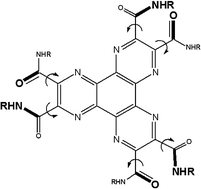Self-assembly of hydrogen-bond assisted supramolecular azatriphenylene architectures†
Abstract
We report on the self-assembly of a functionalized hexaazatriphenylene into supramolecular architectures where the single

Maintenance work is planned for Wednesday 1st May 2024 from 9:00am to 11:00am (BST).
During this time, the performance of our website may be affected - searches may run slowly and some pages may be temporarily unavailable. If this happens, please try refreshing your web browser or try waiting two to three minutes before trying again.
We apologise for any inconvenience this might cause and thank you for your patience.
* Corresponding authors
a Nanochemistry Laboratory, Institut de Science et d'Ingénierie Supramoléculaires (ISIS) – CNRS 7006, Université Louis Pasteur, 8 allée Gaspard Monge, F-67083 Strasbourg, France
b Laboratoire de Chimie des Polymères, CP 206/1, Université Libre de Bruxelles, Boulevard du Triomphe, B-1050 Bruxelles, Belgium,
c
Institut für Chemie Technische Universität Chemnitz, Straße der Nationen 62, D-09111 Chemnitz, Germany
E-mail:
Matthias.Lehmann@chemie.tu-chemnitz.de
Fax: +49-371-5311839
d
Istituto per la Sintesi Organica e la Fotoreattività - Consiglio Nazionale delle Ricerche, via Gobetti 101, I-40129 Bologna, Italy
E-mail:
samori@isof.cnr.it
Fax: +39-051-6399844
We report on the self-assembly of a functionalized hexaazatriphenylene into supramolecular architectures where the single

 Please wait while we load your content...
Something went wrong. Try again?
Please wait while we load your content...
Something went wrong. Try again?
M. Palma, J. Levin, O. Debever, Y. Geerts, M. Lehmann and P. Samorì, Soft Matter, 2008, 4, 303 DOI: 10.1039/B713570J
To request permission to reproduce material from this article, please go to the Copyright Clearance Center request page.
If you are an author contributing to an RSC publication, you do not need to request permission provided correct acknowledgement is given.
If you are the author of this article, you do not need to request permission to reproduce figures and diagrams provided correct acknowledgement is given. If you want to reproduce the whole article in a third-party publication (excluding your thesis/dissertation for which permission is not required) please go to the Copyright Clearance Center request page.
Read more about how to correctly acknowledge RSC content.
 Fetching data from CrossRef.
Fetching data from CrossRef.
This may take some time to load.
Loading related content
